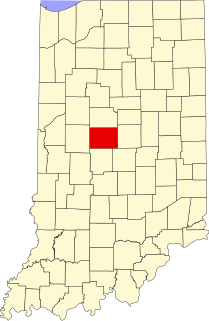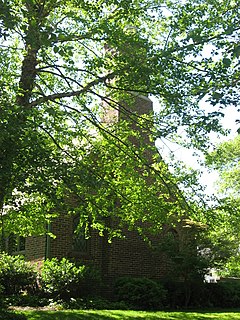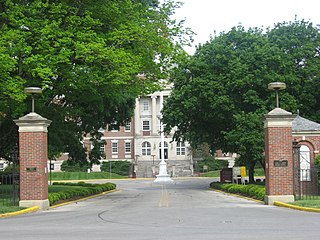
This is intended to be a complete list of properties and districts listed on the National Register of Historic Places in Orleans County, New York. The locations of National Register properties and districts may be seen in a map by clicking on "Map of all coordinates". Two listings, the New York State Barge Canal and the Cobblestone Historic District, are further designated a National Historic Landmark.

The DeForest Skinner House or Skinner Homestead, is a place on the National Register of Historic Places in Valparaiso, Indiana. It was placed on the Register on June 24, 2008. Built around 1860, it is a two-story carpentered Italianate structure with a double brick foundation, weatherboard walls, and asphalt roof, located three blocks north of the Porter County Courthouse. The register listing includes a carriage stepping stone by the north porch, with the family name upon it.

This is a list of properties and districts in the southern municipalities of Puerto Rico that are listed on the National Register of Historic Places. It includes places along the southern coast of the island, and on the south slope of Puerto Rico's Cordillera Central.

This is a list of the National Register of Historic Places listings in Boone County, Indiana.

There are 73 properties listed on the National Register of Historic Places in Albany, New York, United States. Six are additionally designated as National Historic Landmarks (NHLs), the most of any city in the state after New York City. Another 14 are historic districts, for which 20 of the listings are also contributing properties. Two properties, both buildings, that had been listed in the past but have since been demolished have been delisted; one building that is also no longer extant remains listed.

Orndoff-Cross House, also known as the Henry Orndoff House, is a historic home located at Martinsburg, Berkeley County, West Virginia. It was built about 1796 and consists of a log house with additions. The earliest addition dates from about 1830 and the latest from the 1990s. It is a two-story vernacular residence topped by a standing seam metal, side gable roof. Also on the property is a meat-hanging shed of log construction.

Hite-Finney House was a historic building at 183 North Jefferson Street in Martinsville, Morgan County, Indiana. It was built in 1855, and was a two-story, transitional Greek Revival / Italianate style brick I-house. It has been demolished.

The William B. McCallum House, built in 1887, is an Italianate Style house in Valparaiso, Indiana contains many of the basic elements of Italianate design, including brick masonry, deep eves, thick cornice features of wood and protruding flattened arch brick window lintels and a two-story bay window.

The Italianate House at 608 Academy Street, Valparaiso, Indiana was constructed by Conrad and Catherine Bloch in about 1873. The double-pile brick house has a commanding presence on a double lot at the corner of Park and Academy Streets. A brick woodhouse dates to about the same period as the house. The garage dates from about 1940. The house was converted to the Valparaiso Hospital and Sanitarium by Dr. Harvey Cook in about 1923. It has been converted back to a single family home.

Charles S. and Mary McGill House is a historic home located at Valparaiso, Porter County, Indiana. It was built in 1926, and is a two-story, "Z"-shaped Tudor Revival style brick dwelling. It has a steeply pitched cross-hipped roof and features stuccoed areas with half-timbering and massive chimneys.

Good Fellow Club Youth Camp is a historic summer camp and a national historic district located at Porter, Porter County, Indiana. The district encompasses nine contributing buildings, seven contributing structures, and one contributing site built by U.S. Steel for its employees' children. The contributing resources include the camp site with roadways and foundations of removed buildings, administration building, gate house and flagstone wall (1946), caretaker's house and garage (1941), pool house (1946), steel footbridge, steel swimming pool (1946), riflery, and tennis courts (1946). The buildings reflect the Adirondack rustic and American Craftsman architectural styles. The camp remained in operation until 1976, and is now part of the Indiana Dunes National Lakeshore.

Indianapolis Veterans Administration Hospital, also known as Larue D. Carter Memorial Hospital is a historic hospital complex and national historic district located at Indianapolis, Indiana. The district resources were developed between 1930 and 1951 by the Veterans Administration, and encompasses 15 contributing buildings, 2 contributing sites, 2 contributing structures and 5 contributing objects on the hospital campus. The main complex is connected by an enclosed corridor and consists of the main hospital building (1931), kitchen/mess hall/boiler house/attendants' quarters, general medical building (1939), and recreation building (1941). The buildings reflect the Colonial Revival and Classical Revival styles of architecture.

The Harriett was a historic apartment building located at Indianapolis, Indiana. It was built about 1905, and was a three-story, "U"-shaped, Classical Revival style yellow brick and grey limestone building. It has been demolished.

The Chadwick was a historic apartment building located at Indianapolis, Indiana. It was built in 1925, and was a three-story, five bay, "I"-shaped, Georgian Revival style buff brick building with limestone detailing. It featured Tuscan order engaged columns at the entrance. It was destroyed by fire in January 2011.

Willard and Josephine Hubbard House is a historic home located at Indianapolis, Indiana. It was built in 1903, and is a 2+1⁄2-story, five-bay, center-hall plan, Italian Renaissance Revival style limestone dwelling with an addition. It features a front wooden portico supported by Ionic order columns and a semi-circular front section. Also on the property is a contributing carriage house / garage.

Horner–Terrill House is a historic home located at Indianapolis, Indiana. It was built about 1875, and is a 2+1⁄2-story, roughly "L"-shaped, Second Empire style brick dwelling with limestone detailing. It features a three-story tower, mansard roof, and round arched openings. Also on the property is a contributing garage. It was listed on the National Register of Historic Places in 2013.

Watson Park Historic District, also known as Watson Road Historic District and Watson McCord Neighborhood, is a national historic district located at Indianapolis, Indiana. The district encompasses 402 contributing buildings and 4 contributing sites in a predominantly residential section of Indianapolis. They include 255 houses, 27 multiple family dwellings, and 120 garages. It was developed between about 1910 and 1960, and includes representative examples of Colonial Revival, Tudor Revival, and Bungalow / American Craftsman style architecture. Located in the district is the Watson Park Bird Sanctuary.

Gaseteria, Inc., also known as ACLU, Indiana, historic apartment building located at Indianapolis, Indiana. It was built in 1941, and is a one-story, Art Moderne style, buff-color and red brick building with limestone detailing and a flat roof. It features curved walls and glass-block windows. It was built to house the offices of the Gaseteria filling station company.
Old Hose House No. 4, also known as Whiting Sheet Metal, was a historic fire station located in downtown Evansville, Indiana. It was built in 1860. It has been demolished.





















